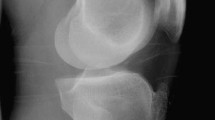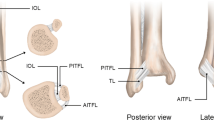Abstract
Purpose
Ultrasound (US) is a valuable tool for the evaluation of chronic lateral instability of the ankle; however, the feasibility of US for calcaneofibular ligament (CFL) assessment remains unknown. This study aimed to depict and compare CFL on US in various ankle positions to determine the optimal method for evaluating CFL with US and to interpret US findings using cadaveric specimens.
Methods
The US study included 43 ankles of 25 healthy individuals. The CFL was scanned with US in 20° plantar flexion, neutral position, 20° dorsiflexion and maximum dorsiflexion. The distances between fibula and CFL were compared. The cadaveric study included macroscopic qualitative observation of the dynamic change of CFL in 7 ankles and quantitative observation of the directions of CFL and footprints in 17 ankles.
Results
In the US study, the mean distance (mm) between fibula and CFL was 7.3 ± 1.3 in 20° plantar flexion, 6.7 ± 1.6 in neutral position, 4.3 ± 2.5 in 20° dorsiflexion and 3.1 ± 2.1 in maximum dorsiflexion. The more dorsiflexed the ankle was, the shorter the distance between fibula and CFL was (Jonckheere’s trend test p < 0.001). In the cadaveric study, the CFL fibres were aligned parallel between the mid-substance and the fibular attachment in maximum dorsiflexion, whilst CFL was reflected and rotated in plantar flexion.
Conclusions
The whole length of the CFL, including its fibular attachment, is more likely to be visualized with US in dorsiflexion than in plantar flexion due to the direction of the CFL at the fibular attachment, which is parallel with the mid-substance in maximum dorsiflexion.
Level of evidence
IV.




Similar content being viewed by others
References
Buzzi R, Todescan G, Brenner E, Segoni F, Inderster A, Aglietti P (1993) Reconstruction of the lateral ligaments of the ankle: an anatomic study with evaluation of isometry. J Sports Traumatol Rel Res 15:55–74
Cai Y, Li S, Chen S, Hua Y, Shan J (2017) An ultrasound classification of anterior talofibular ligament (ATFL) injury. Open Orthop J 11:610–616
de Maeseneer DM, Marceils S, Jager T et al (2009) Sonography of the normal ankle: a target approach using skeletal reference points. AJR Am J Roentgenol 192:487–495
Cao S, Wang C, Ma X, Wang X, Huang J, Zhang C (2018) Imaging diagnosis for chronic lateral ankle ligament injury: a systemic review with meta-analysis. J Orthop Surg Res 13:122
Cheng Y, Cai Y, Wang Y (2014) Value of ultrasonography for detecting chronic injury of the lateral ligaments of the ankle joint compared with ultrasonography findings. Br J Radiol 87:20130406
Clanton TO, Campbell KJ, Wilson KJ et al (2014) Qualitative and quantitative anatomic investigation of the lateral ankle ligaments for surgical reconstruction procedures. J Bone Joint Surg Am 96:e98
Edama M, Kageyama I, Kikumoto T et al (2017) The effects on calcaneofibular ligament function of differences in the ankle of the calcaneofibular ligament with respect to the long axis of the fibula: a simulation study. J Foot Ankle Res 10:60
Frost SC, Amendola A (1999) Is stress radiography necessary in the diagnosis of acute or chronic ankle instability? Clin J Sport Med 9:40–45
Golano P, Vega J, de Leeuw PA et al (2016) Anatomy of the ankle ligaments: a pictorial essay. Knee Surg Sports Traumatol Arthrosc 24:944–956
Gregush RV, Ferkel RD (2010) Treatment of the unstable ankle with an osteochondral lesion: results and long-term follow-up. Am J Sports Med 38:782–790
Hashimoto T, Inokuchi S, Kokubo T (2009) Clinical study of chronic lateral ankle instability: injured ligaments compared with stress X-ray examination. J Orthop Sci 14:699–703
Healy SE, Rai BP, Biyani CS, Eisma R, Soames RW, Nabi G (2015) Thiel embalming method for cadaver preservation: a review of new training model for urologic skills training. Urology 85:499–504
Inman VT (1976) The joints of the ankle. Williams and Wilkins, Baltimore, pp 70–73
Lee KT, Park YU, Jegal H, Park JW, Choi JP, Kim JS (2014) New method of diagnosis for chronic ankle instability: comparison of manual anterior drawer test, stress radiography and stress ultrasound. Knee Surg Traumatol Arthrosc 22:1701–1707
Martinoli C (2010) Musculoskeletal ultrasound: technical guidelines. Insights. Imaging 1:99–141
Matsui K, Takao M, Tochigi Y, Ozeki S, Glazebrook M (2017) Anatomy of anterior talofibular ligament and calcaneofibular ligament for minimally invasive surgery: a systematic review. Knee Surg Sports Traumatol Arthrosc 25:1892–1902
Milz P, Milz S, Putz R, Reiser M (1996) 13 MHz high-frequency sonography of the lateral ankle joint ligaments and the tibiofibular syndesmosis in anatomic specimens. J Ultrasound Med 15:277–284
Minagawa H (2014) Musculoskeletal ultrasound: echo anatomy and scan technique. Ohmsha, Tokyo, pp 195–197
Neuschwander TB, Indressano AA, Hugh TH, Smith BW (2013) Footprint of the lateral ligament complex of the ankle. Foot Ankle Int 34:582–586
Oae K, Takao M, Uchio Y, Ochi M (2010) Evaluation of anterior talofibular ligament injury with stress radiography, ultrasonography and MR imaging. Skelet Radiol 39:41–47
Özçakar L, Kara M, Chang KV et al (2015) Euro-musculus/USPRM. Basic scanning protocols for ankle and foot. Eur J Phys Rehabil Med 51:647–653
Park HJ, Cha SD, Kim SS et al (2012) Accuracy of MRI findings in chronic lateral ankle ligament injury: comparison with surgical findings. Clin Radiol 67:313–318
Park HJ, Lee SY, Park NH et al (2015) Usefulness of the oblique coronal plane in ankle MRI of the calcaneofibular ligament. Clin Radiol 70:416–423
Peetrons P, Creteur V, Bacq C (2004) Sonography of ankle ligaments. J Clin Ultrasound 32:491–499
Pellegrini MJ, Glisson RR, Wurm M et al (2016) Systematic quantification of stabilizing effects of subtalar joint soft-tissue constraints in a novel cadaveric model. J Bone Jt Surg Am 98:842–848
Precerutti M, Bonardi M, Ferrozzi G et al (2013) Sonographic anatomy of the ankle. J Ultrasound 17:79–87
Radwan A, Bakowski J, Dew S, Greenwald B, Hyde E, Webber N (2016) Effectiveness of ultrasonography in diagnosing chronic lateral ankle instability: a systematic review. Int J Sports Phys Ther 11:164–174
Ruth CJ (1961) The surgical treatment of injuries of the fibular collateral ligaments of the ankle. J Bone Joint Surg Am 43:229–239
Wiersma PH, Griffioen FMM (1992) Variations of three lateral ligaments of the ankle. A descriptive anatomical study. Foot 2:218–224
Acknowledgements
This study was partly supported by a grant from JA Kyosai Research Institute (Agricultural Cooperative Insurance Research Institute).
Funding
This study was partly supported by a grant from JA Kyosai Research Institute (Agricultural Cooperative Insurance Research Institute).
Author information
Authors and Affiliations
Corresponding author
Ethics declarations
Conflict of interest
All authors declare that they have no conflict of interest.
Ethical approval
All procedures performed on human participants were in accordance with the ethical standards of the institutional and/or national research committee and with the 1964 Helsinki declaration and its later amendments or comparable ethical standards.
Informed consent
Informed consent was obtained from all individual participants included in the study.
Additional information
Publisher's Note
Springer Nature remains neutral with regard to jurisdictional claims in published maps and institutional affiliations.
Rights and permissions
About this article
Cite this article
Hattori, S., Nimura, A., Koyama, M. et al. Dorsiflexion is more feasible than plantar flexion in ultrasound evaluation of the calcaneofibular ligament: a combination study of ultrasound and cadaver. Knee Surg Sports Traumatol Arthrosc 28, 262–269 (2020). https://doi.org/10.1007/s00167-019-05630-z
Received:
Accepted:
Published:
Issue Date:
DOI: https://doi.org/10.1007/s00167-019-05630-z




